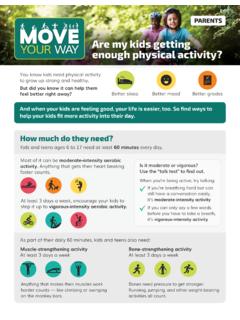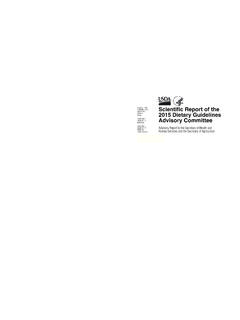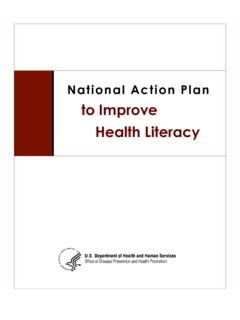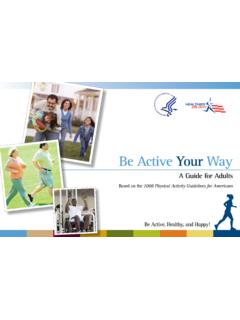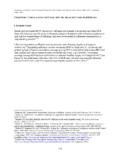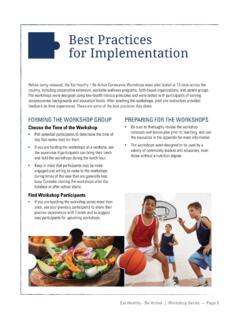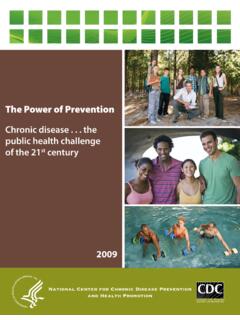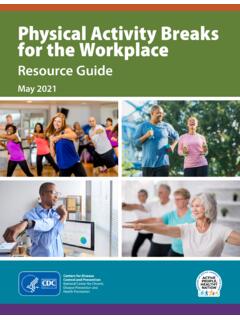Transcription of Physical Activity Guidelines for Americans - Health
1 Physical Activity Guidelines for Americans | Executive Summary 1 Physical Activity Guidelines for Americans SummaryBeing physically active is one of the most important actions that people of all ages can take to improve their Health . The evidence reviewed for this second edition of the Physical Activity Guidelines for Americans is clear Physical Activity fosters normal growth and development and can make people feel better, function better, sleep better, and reduce the risk of a large number of chronic diseases. Health benefits start immediately after exercising, and even short episodes of Physical Activity are beneficial. Even better, research shows that just about everyone gains benefits: men and women of all races and ethnicities, young children to older adults, women who are pregnant or postpartum (first year after delivery), people living with a chronic condition or a disability, and people who want to reduce their risk of chronic disease.
2 The evidence about the Health benefits of regular Physical Activity is well established, and research continues to provide insight into what works to get people moving, both at the individual and community level. Achieving the benefits of Physical Activity depends on our personal efforts to increase Activity in ourselves, family, friends, patients, and colleagues. Action is also required at the school, workplace, and community levels. What s New in This Edition?This second edition of the Physical Activity Guidelines for Americans provides science-based guidance to help people ages 3 years and older improve their Health through participation in regular Physical Activity . It reflects the extensive amount of new knowledge gained since the publication of the first Physical Activity Guidelines for Americans , released in 2008. This edition of the Guidelines discusses the proven benefits of Physical Activity and outlines the amounts and types of Physical Activity recommended for different ages and populations.
3 Physical Activity Guidelines for Americans2nd editionExecutive SummaryPhysical Activity Guidelines for Americans | Executive Summary 2 For example, new aspects include discussions of: Additional Health benefits related to brain Health , additional cancer sites, and fall-related injuries; Immediate and longer term benefits for how people feel, function, and sleep; Further benefits among older adults and people with additional chronic conditions; Risks of sedentary behavior and their relationship with Physical Activity ; Guidance for preschool children (ages 3 through 5 years); Elimination of the requirement for Physical Activity of adults to occur in bouts of at least 10 minutes; and Tested strategies that can be used to get the population more the Physical Activity GuidelinesThe Physical Activity Guidelines for Americans is issued by the Department of Health and Human Services (HHS).
4 It complements the Dietary Guidelines for Americans , a joint effort of HHS and the Department of Agriculture (USDA). Together, the two documents provide guidance for the public on the importance of being physically active and eating a healthy diet to promote good Health and reduce the risk of chronic primary audience for the Physical Activity Guidelines for Americans is policy makers and Health professionals, though it may also be useful to interested members of the public. The main idea behind the Guidelines is that regular Physical Activity over months and years can produce long-term Health benefits. The development of this edition of the Physical Activity Guidelines for Americans started in 2016 when former HHS Secretary Sylvia Mathews Burwell appointed an external scientific advisory committee, the 2018 Physical Activity Guidelines Advisory Committee.
5 The Committee conducted a series of systematic reviews of the scientific literature on Physical Activity and Health and met periodically in public session to discuss their findings. The Committee s work was compiled into a scientific report summarizing the current evidence. The 2018 Physical Activity Guidelines Advisory Committee Scientific Report and summaries of the Committee s meetings are available at Activity Guidelines for Americans | Executive Summary 3 When writing the Guidelines , HHS used the Advisory Committee s Scientific Report as its primary source but also considered comments from the public and government agencies. The Guidelines will be widely promoted through various communications strategies online and in print, such as the Move Your Way campaign materials for professionals and consumers, and partnerships with organizations that promote Physical GuidelinesBelow are the key Guidelines included in the Physical Activity Guidelines for Guidelines for Preschool-Aged Children Preschool-aged children (ages 3 through 5 years) should be physically active throughout the day to enhance growth and development.
6 Adult caregivers of preschool-aged children should encourage active play that includes a variety of Activity Guidelines for Children and Adolescents It is important to provide young people opportunities and encouragement to participate in Physical activities that are appropriate for their age, that are enjoyable, and that offer variety. Children and adolescents ages 6 through 17 years should do 60 minutes (1 hour) or more of moderate-to-vigorous Physical Activity daily: Aerobic: Most of the 60 minutes or more per day should be either moderate- or vigorous-intensity aerobic Physical Activity and should include vigorous-intensity Physical Activity on at least 3 days a week. Muscle-strengthening: As part of their 60 minutes or more of daily Physical Activity , children and adolescents should include muscle-strengthening Physical Activity on at least 3 days a week.
7 Bone-strengthening: As part of their 60 minutes or more of daily Physical Activity , children and adolescents should include bone-strengthening Physical Activity on at least 3 days a week. Physical Activity Guidelines for Americans | Executive Summary 4 Key Guidelines for Adults Adults should move more and sit less throughout the day. Some Physical Activity is better than none. Adults who sit less and do any amount of moderate-to-vigorous Physical Activity gain some Health benefits. For substantial Health benefits, adults should do at least 150 minutes (2 hours and 30 minutes) to 300 minutes (5 hours) a week of moderate-intensity, or 75 minutes (1 hour and 15 minutes) to 150 minutes (2 hours and 30 minutes) a week of vigorous-intensity aerobic Physical Activity , or an equivalent combination of moderate- and vigorous-intensity aerobic Activity .
8 Preferably, aerobic Activity should be spread throughout the week. Additional Health benefits are gained by engaging in Physical Activity beyond the equivalent of 300 minutes (5 hours) of moderate-intensity Physical Activity a week. Adults should also do muscle-strengthening activities of moderate or greater intensity and that involve all major muscle groups on 2 or more days a week, as these activities provide additional Health benefits. Key Guidelines for Older AdultsThe key Guidelines for adults also apply to older adults. In addition, the following key Guidelines are just for older adults: As part of their weekly Physical Activity , older adults should do multicomponent Physical Activity that includes balance training as well as aerobic and muscle-strengthening activities. Older adults should determine their level of effort for Physical Activity relative to their level of fitness.
9 Older adults with chronic conditions should understand whether and how their conditions affect their ability to do regular Physical Activity safely. When older adults cannot do 150 minutes of moderate-intensity aerobic Activity a week because of chronic conditions, they should be as physically active as their abilities and conditions Activity Guidelines for Americans | Executive Summary 5 Key Guidelines for Women During Pregnancy and the Postpartum Period Women should do at least 150 minutes (2 hours and 30 minutes) of moderate-intensity aerobic Activity a week during pregnancy and the postpartum period. Preferably, aerobic Activity should be spread throughout the week. Women who habitually engaged in vigorous-intensity aerobic Activity or who were physically active before pregnancy can continue these activities during pregnancy and the postpartum period.
10 Women who are pregnant should be under the care of a Health care provider who can monitor the progress of the pregnancy. Women who are pregnant can consult their Health care provider about whether or how to adjust their Physical Activity during pregnancy and after the baby is Guidelines for Adults With Chronic Health Conditions and Adults With Disabilities Adults with chronic conditions or disabilities, who are able, should do at least 150 minutes (2 hours and 30 minutes) to 300 minutes (5 hours) a week of moderate-intensity, or 75 minutes (1 hour and 15 minutes) to 150 minutes (2 hours and 30 minutes) a week of vigorous-intensity aerobic Physical Activity , or an equivalent combination of moderate- and vigorous-intensity aerobic Activity . Preferably, aerobic Activity should be spread throughout the week. Adults with chronic conditions or disabilities, who are able, should also do muscle-strengthening activities of moderate or greater intensity and that involve all major muscle groups on 2 or more days a week, as these activities provide additional Health benefits.


